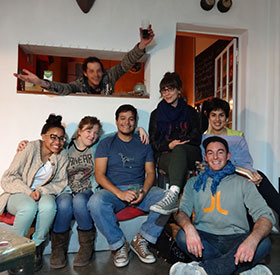 Residencia Corazón, Argentina
Residencia Corazón, Argentina
Sebastian Befumo
August 2014
After spending a few days in Buenos Aires to ease my way into Argentinian culture, I packed my gear and scrambled for the 129 bus to La Plata. I had previously researched a little about La Plata, its structure and history, and was very interested in its memorialisation of events from the 1970s until now and its planned urban design, established in the late 19th century. The city centre is a strict grid design, but with eight diagonal roads slicing through it. Apart from the apparent conceptual basis for this design, the diagonals, if used properly, made for quicker routes, but I found them strangely disorienting.
Once I had arrived in the city, I left the bus at Plaza Italia and started walking down Diagonal 77, one of La Plata’s misleading diagonal roads. After a long walk, doubtful that I was headed in the right direction, I spotted Corazón’s doors. I had seen photos of this place many times and it was surreal to finally arrive. I had never travelled this far or undertaken a residency before, so it was thrilling to finally be entering this space and to meet the directors whom I had been in contact with – and also stalking on their website – for over a year. Being the super prompt freak that I am, I had arrived early. The directors Rodrigo Mirto and Juan Pablo Ferrer had not yet arrived however, I was greeted by two other artists also residing in Corazón. I wasn’t aware, but was pleasantly surprised, that...
over the next three months I would see six other artists and writers pass through the residency and create work. This made for fantastic, international networking opportunities and very fun, Fernet-filled evenings.
Once the directors had arrived, I was shown around the residency and the neighbourhood.
The residency is an eclectic mix; ten years’ worth of artist’s works and materials, including those of the directors themselves, left the place loaded. Bedrooms and living areas are awkwardly engineered, overflowing with random, colourful objects across the walls. It’s a very lived-in space, full of imagination, colour and warmth. Outside the residency felt much the same. Socially and politically engaging graffiti are strewn across almost every surface reachable at ground level. Modern and traditional styles of architecture bump up against one another and public spaces, such as the Paseo del Bosque, are filled with activity.

Everywhere you look there are signs of life, evidence of how people and the elements have integrated themselves into the physical and historical context of La Plata. It’s a city founded on utopian ideals of order and hygiene, but has been beautifully transformed into something more fluid. It was these observations that served as the basis for new work in La Plata.
My experience of making work and developing relationships far exceeded my expectations. What made this residency particularly dear to me, and the other residents, were the directors and their families. Juan and Rodrigo have created a space where you feel as if you’re part of the family. Almost every day you are greeted with kisses, invitations to socialise, network, share mate or malbec, organise asados for the weekend or assisted in any way possible with your project. Residencia Corazón is a very social space, but I was also able to intensively create work and reflect on my practice without distractions. These processes were of vital importance to my residency and have enabled new methodologies to develop, (bringing) a new perspective on my practice that will no doubt be beneficial for years to come.
Sebastian Befumo was a 2014 recipient of the Department of Culture and the Arts, Young People and the Arts Fellowship. He carried out a residency at Residencia Corazon, Argentina, as part of his Fellowship.
The Residencia Corazón - Corazón Artist in Residency (AIR) program was initiated in 2006. Conceived by Rodrigo Mirto and Juan Pablo Ferrer, its main objective engenders the creation of a personalized and independent exchange among regional, national and international artists.
This article featured in the Artsource Newsletter, Summer 2014/15.
Artsource supports the practice of professional artists with the Global City Residencies.